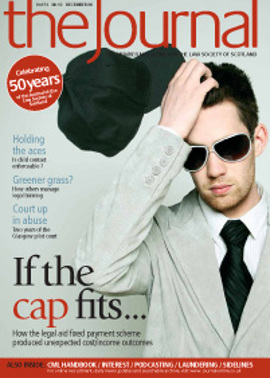Hung out to dry

In relative terms the Simple Guide is indeed simple. It runs to barely 30 pages and attempts to give guidance to the profession on the Second EU Directive 2001, the Proceeds of Crime Act 2003 (462 sections and 12 schedules) and the Money Laundering Regulations 2003 (SI 2003/3075). It is worth mentioning that the Simple Guide is currently under review.
Is “satisfactory” satisfactory?
Much of the guidance relates to attempts to interpret regs 4(3) and 2(5) of the 2003 Regulations, set out in the panel.
Essentially you have an obligation to record satisfactory evidence of the identity of your client at the earliest reasonable opportunity. The legislation and regulations do not fully define “satisfactory”. The Simple Guide and indeed other guidance to other professions on the same issue all endeavour to assist members in complying with the word “satisfactory”.
The other area which the Simple Guide attempts to interpret is the obligation to report “suspicious circumstances”. Again this is not defined within the legislation and regulations in a particularly satisfactory way.
If in doubt, check it out
In reality solicitors can help protect themselves from perceptions by the authorities that they are either turning a blind eye to money laundering or simply being cavalier, by operating robust and reliable procedures both in terms of identifying their clients and the source of funds, and keeping a general conscious awareness of “suspicious” transactions.
The Professional Practice and the Guarantee Fund teams at the Society are always available should you wish either to discuss the adequacy of ID, or get a third party dispassionate view as to whether or not circumstances are “suspicious”. Many members of the Society take advantage of this facility, and this is particularly useful to the Society in identifying possible patterns of criminal behaviour and warning the profession regarding these. “If in doubt, check it out” is a good motto.
In July there were two separate convictions of solicitors in England in relation to money laundering activity. A Shrewsbury solicitor who in the judge’s view “closed his eyes to the obvious”, was sentenced to 15 months’ imprisonment (recently reduced to six months on appeal) for failing to disclose to the authorities that he knew or suspected that a money laundering offence was taking place. And a solicitor from Northern Ireland was jailed for three months at Liverpool Crown Court for converting or transferring the proceeds of criminal conduct.
The weakest links
Approximately once per fortnight the Professional Practice team hear from a solicitor who has police officers standing in front of him with a production order seeking delivery of a file in relation to an ongoing money laundering or proceeds of crime inquiry. Often the inquiry was prompted by the solicitor reporting the matter to NCIS (now SOCA), and the solicitor has no personal exposure in the matter other than the hassle of dealing with the order and precognition.
The most common problems which inquirers discuss with the Professional Practice Department relating to money laundering arise from the following:
(1) Failure to have robust procedures. The procedures exist, but they are routinely bypassed with statements such as “I know him: he’s all right”. Senior management in any firm should make clear to all staff that the procedures cannot be circumvented and failure to follow procedures will have internal disciplinary consequences.
(2) There are delays in getting ID. For example offers are submitted without ID being in place, either due to poor implementation of procedures or the client deliberately failing to produce ID. In any event submitting an offer constitutes carrying out work, and to do so without identity in place puts the solicitor and indeed the firm at risk. In my view it is prudent to make it impossible to open a file or client matter without ID in place, effectively preventing any work being carried out until it is available. It should also be noted that there is the further risk, if the offer is accepted and client disappears, that you may have submitted an offer for a non-existent client, creating a personal liability under the contract on the firm.
(3) Inadequate identity verification. Naively or otherwise, I believe that the profession does have routine identity pretty well organised. The difficulties mainly seem to arise with clients or sources of funds which do not fit the normal profile. Pensioners with no passport or driving licence, people working abroad, people in the services, clients at a distance, unusual corporate bodies, companies whose directors and shareholders are other companies, bodies who reside in or are subject to foreign jurisdictions, language difficulties etc. If you are unfamiliar with how to deal with any particular type of client identity, please check with the Professional Practice Department.
(4) Staff training. The regulations require all staff to be trained, and there are huge benefits to solicitors in even junior staff having a basic understanding of the regulations, particularly in regard to identity and suspicious circumstances.
(5) Failure to keep central records of how ID was verified. Many firms who do keep records of identity procedures on individual files fail to appreciate the benefit of keeping a second central record, and while it is accepted that this is a further chore it is a useful failsafe.
Online checking services
The Society has recently examined a provider of online identity verification, namely Callcredit’s “CallML” product. There are of course other providers of electronic verification who offer similar products.
These systems provide assistance in the anti-money laundering verification procedure. Essentially they are online systems into which you key several mandatory identity details provided by your client. A search of databases is performed after a title, forename, surname, house number, postcode and date of birth have been entered.
The system checks against several databases including the full, unedited electoral roll, Royal Mail postcode address file, UK investors, Adverse Public Data, and Share financial records. Additional checks are also carried out against other databases such as Directors at Home, Politically Exposed Persons, Specially Designated Nationals and Bank of England Sanctions.
Although the system negates the need for paper based documents, you are able to enter a number of government-issued document details if you so wish. Algorithms are run against driving licence numbers, passport numbers and national insurance numbers to ensure that the details match the identity information given by the client. Passport numbers are also checked against the lost and stolen passport file.
Paper based documents can be used in combination with the electronic checks to allow “extra checks” to be undertaken. These can also be of additional reassurance against forged documentation or identity theft, for compliance with items (1) and (2) and in unusual identifications as in (3) above. Online training modules are available to assist with item (4). The data are also audit tracked and stored on secure servers under the service agreement, taking care of (5) above.
The systems are able to verify identity in situations where the client is never met face-to-face (“client not present” cases). The Society has considered the CallML system in this regard, and while we do not endorse the product, the view of the Society is that it appears robust. Procedures should be risk-based and proportionate, and verification of identity need not take exactly the same form in all cases. It is up to individual solicitors to take a view.
The three out of four test
The CallML product approaches the matter laterally, and provided your client can be contacted on the telephone, it relies on the client’s ability to answer a series of questions to vouch that they are indeed who they say they are. The system provides a significant bank of additional information relating to the client and permits questions to be asked such as:
- “How many credit cards do you hold?”
- “How many bank accounts do you have?”
- “Do you have a second or third mortgage on your property?”
- “How long have you lived at your present address?”
The Society’s view is that having obtained the usual ID documentation, but without the ability to see your client face-to-face and compare the picture to the photographic ID, you can then ask the client a series of questions. If your client is able to answer three out of four of the questions correctly, then although you have not met the client face to face, you have taken reasonable steps to satisfy yourself as to their identity.
For the avoidance of doubt, the reason that three out of four questions is suggested rather than four out of four is quite simply because a significant number of people simply do not remember all these facts.
The Society does however think that these type of systems offer additional channels by which solicitors can perform anti-money laundering checks quickly to verify ID at relatively low cost – as may a variety of other systems which we have not as yet considered.
I am confident that as you sit reading this article (assuming you have not lapsed into unconsciousness) you are not quietly waiting for the next piece of business to come in the door to put on your empty desk. I refuse to believe that as a busy solicitor you need to undertake questionable, problematic business which sucks up time and resources for little reward, and accordingly I would urge you, if in doubt, to avoid taking on transactions where you just cannot satisfy yourself as to the client’s identity, source of funds or indeed the true nature of the transaction. The July prosecutions in England make it clear that “closing your eyes to the obvious” is an unacceptable risk. If in doubt feel free to run the circumstances past Bruce Ritchie, James Ness, or Fiona J Robb of the Professional Practice Department on our confidential helpline.
James Ness, Deputy Director of Professional Practice (t: 0131 476 8174)KEY PROVISIONS
The Money Laundering Regulations 2003 provide: Regulation 4(3):
“A must maintain identification procedures which – (a) require that as soon as is reasonably practicable after contact is first made between A and B – (i) B must produce satisfactory evidence of his identity; or (ii) such measures specified in the procedures must be taken in order to produce satisfactory evidence of B’s identity”.
Regulation 2(5):
“For the purposes of these Regulations, and subject to paragraph (6), ‘satisfactory evidence of identity’ is evidence which is reasonably capable of establishing (and does in fact establish to the satisfaction of the person who obtains it) that the applicant for business is the person he claims to be.”
In this issue
- Costume Wars: copyright storm over the troopers
- The end of the beginning
- Public appointment: public interest
- Fixed payments: a real impact?
- Training: the bigger picture
- Contact breakers
- Abuse in the system
- Stirring up interest
- Twin-tracking law reform
- Hung out to dry
- Fraud: the client's perspective
- The proof is in the podding
- How did you do?
- Old friends revisited
- A reprieve for landlords?
- Smell of success
- There's no case like Rome
- Hurt in the pocket
- Flotation and the trustee
- Scottish Solicitors' Discipline Tribunal
- Website reviews
- Book reviews
- Risk and the in-house lawyer
- The CML Handbook revised
- Ten things you should know about SDLT
- All change at the Registers






